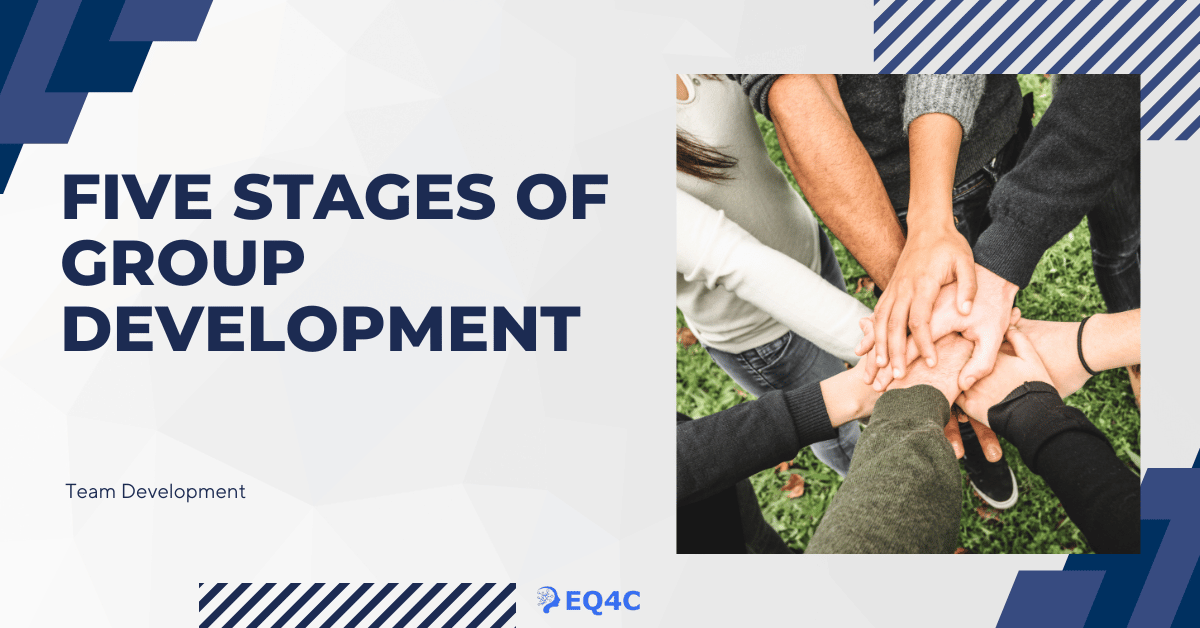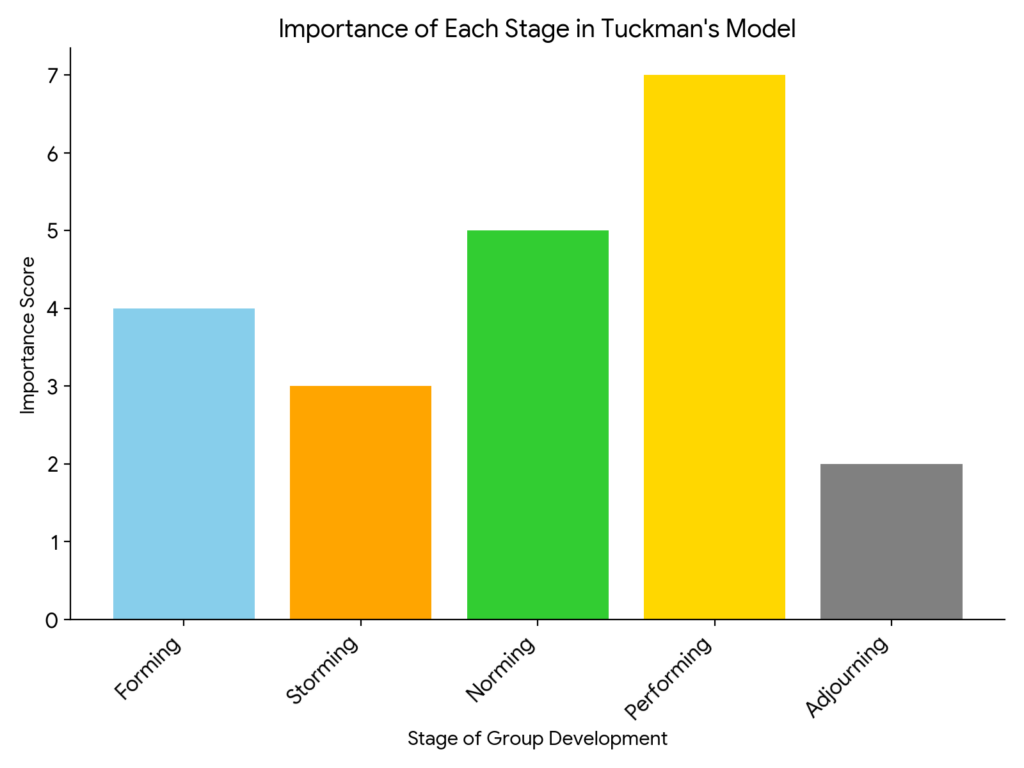Bruce Tuckman’s Five Stages of Group Development

Have you ever wondered what makes some teams unstoppable, achieving goals while others struggle to find their rhythm?
The answer lies in understanding the fundamental stages of group development, a roadmap to navigating the complexities of team dynamics.
This article help you in taking a practical approach into the groundbreaking model proposed by Bruce Tuckman, a renowned psychologist who identified five distinct phases through which every team evolves: Forming, Storming, Norming, Performing, and Adjourning.
By unveiling the hallmark characteristics, challenges, and opportunities of each stage, this toolkit will equip you with the knowledge to:
- Identify your team’s current position in the developmental journey.
- Anticipate and navigate potential roadblocks within group dynamics.
- Foster a collaborative and productive environment for optimal results.
- Optimize your leadership style to match each stage’s specific needs.
Whether you’re a seasoned leader or just starting your teamwork journey, unlocking the secrets of Tuckman’s Five Stages holds the key to building a high-performing team that thrives on collaboration and effectiveness.
Ready to embark on this insightful exploration?
Dive into the article and unlock the transformative power of understanding group development.
An Overview of Bruce Tuckman’s Work
When it comes to effective group functioning, understanding the stages of group development is crucial. Bruce Tuckman, a psychologist, is well-known for his work on the stages of group development, which he outlined in his 1965 article “Developmental Sequence in Small Groups.”
In this article, Tuckman proposed a model that describes the stages a group goes through as it develops over time.
According to Tuckman’s model, groups progress through five distinct stages: forming, storming, norming, performing, and adjourning. Each stage has its own characteristics and challenges, and understanding these stages can help group members and leaders anticipate and address issues that may arise.
Why Understanding Group Development is Important
There are several reasons why understanding the stages of group development is important for effective group functioning:
- Anticipating and addressing challenges: By understanding the different stages of group development, group members and leaders can anticipate the challenges that may arise during each stage and take steps to address them before they become more serious issues.
- Fostering teamwork and collaboration: Group members who understand the stages of group development are better equipped to work together effectively and build stronger, more collaborative relationships.
- Achieving better outcomes: By navigating the stages of group development effectively, groups are more likely to achieve their goals and achieve better outcomes overall.
Tuckman’s Five Stages of Group Development
Tuckman’s model of group development consists of five stages that describe the various phases a group goes through as it forms, matures, and ultimately dissolves.

These stages are:
1. Forming
The forming stage is the first stage in Tuckman’s model of group development. During this stage, the group is just starting to come together, and members are often polite and reserved as they get to know each other and understand the group’s purpose. This stage sets the foundation for the group’s development and determines the trajectory for the rest of the stages.
What happens during the forming stage?
In the forming stage, group members typically exhibit certain characteristics and behaviors, such as:
- Politeness and formality: Members are often polite and formal with each other, as they try to establish a positive rapport and get to know each other.
- Uncertainty: Members may feel uncertain or anxious about their roles, responsibilities, and the group’s purpose.
- Dependency: Members may look to the group leader or other members for guidance and direction.
- Exploration: Members may ask questions and gather information about each other and the group’s goals.
- Testing: Members may test the boundaries and rules of the group, to better understand the dynamics and norms.
Example of a group going through the forming stage
Let’s take the example of a newly formed work team. When a new team is formed, members often go through the forming stage as they begin to work together. In this stage, the team members may:
- Introduce themselves and exchange pleasantries
- Clarify their roles and responsibilities
- Discuss the goals and objectives of the team
- Explore each other’s skills and expertise
- Look to the team leader for guidance and direction
- Test the boundaries and norms of the team
As the team progresses through the forming stage, they will begin to move into the storming stage, where conflicts may arise as they work through differences in opinion and approach.
2. Storming
The second stage in Tuckman’s model of group development is the storming stage. In this stage, group members begin to express their individual opinions, ideas, and concerns, which can lead to conflicts and disagreements as they try to work together. The storming stage can be a critical period for the group’s development, as it sets the stage for resolving conflicts and moving towards the norming stage.
What happens during the storming stage?
During the storming stage, group members typically exhibit certain characteristics and behaviors, such as:
- Conflict and disagreements: Members may have different ideas, opinions, and goals, which can lead to conflicts and disagreements as they try to work together.
- Competition: Members may compete for power, influence, and recognition within the group.
- Resistance to direction: Members may resist or question the direction of the group or the authority of the leader.
- Criticism and negative feedback: Members may criticize each other’s ideas or behaviors, which can lead to hurt feelings and tension within the group.
- Difficulty with communication: Members may struggle to communicate effectively, leading to misunderstandings and frustration.
Case study of a group going through the storming stage
Let’s take the example of a team of employees who are struggling to agree on a project direction. During the storming stage, the team may exhibit the following behaviors:
- Some team members may push for one approach to the project, while others advocate for a different approach.
- Members may become competitive or defensive about their ideas, leading to arguments or tension.
- The team leader may struggle to gain consensus and agreement among the team members.
- Members may become critical of each other’s ideas, which can create an atmosphere of negativity and distrust.
- Communication may break down as team members struggle to express their ideas or listen to others.
To move past the storming stage, the team may need to work through their conflicts and differences, establish clearer communication protocols, and build trust among team members.
3. Norming
The norming stage is the third stage of group development, following the forming and storming stages. During this stage, the group begins to work together in a more cohesive manner and members start to develop a shared sense of purpose. This can lead to increased collaboration, cooperation, and communication, which in turn helps the group to become more productive and effective.
What happens during the Norming stage?
During the norming stage, group members start to resolve their differences and develop a sense of unity and common purpose. This stage is characterized by increased collaboration, as individuals begin to understand each other’s strengths and weaknesses and work together to achieve their goals. Some key features of the norming stage include:
- Development of group cohesion: Members start to feel a sense of belonging to the group and a commitment to its success.
- Clear communication: Members become more comfortable expressing their ideas and concerns, and they are more willing to listen to others.
- Creation of group norms: The group establishes shared expectations for behavior and decision-making, which help to guide future interactions.
- Increased focus on goals: The group becomes more goal-oriented and develops a shared sense of purpose.
Example of a Group in the Norming Stage
An example of a group that has successfully navigated the storming stage and is now in the norming stage is a sports team that has worked through early-season disagreements and is now performing well together. For instance, the Golden State Warriors basketball team, led by coach Steve Kerr, went through a storming stage in the 2018-2019 season when they faced a series of internal conflicts, including a heated exchange between Draymond Green and Kevin Durant. However, the team was able to work through these challenges and move into the norming stage, where they developed a shared sense of purpose and a commitment to their team values. As a result, the Warriors were able to improve their communication, trust, and cohesion, and eventually reached the playoffs that year.
4. Performing
The fourth stage of Tuckman’s model of group development is the performing stage. In this stage, the group has successfully navigated the storming and norming stages and has reached a high level of cohesion, productivity, and teamwork. The group is able to work together effectively, achieving its goals and producing high-quality work.
What happens during the performing stage?
During the performing stage, the group typically exhibits the following characteristics:
- Clear roles and responsibilities: Group members have established clear roles and responsibilities, which are well understood and accepted.
- Cohesion and trust: Group members have developed strong bonds and trust, which allows them to work together effectively and efficiently.
- Focus on goals: The group is highly focused on achieving its goals, and there is a strong sense of shared purpose and commitment to success.
- Effective communication: Communication is clear and direct, with minimal misunderstandings or conflicts.
- High productivity: The group is highly productive, achieving its goals and delivering high-quality work.
Case study of a group that has reached the performing stage
An example of a group that has reached the performing stage is a business team that is exceeding its goals and consistently delivering high-quality work. The team may exhibit the following characteristics:
- Members work seamlessly together, leveraging their individual strengths to produce the best results.
- Team members are highly motivated and committed to the success of the team.
- Communication is direct and efficient, with clear protocols and channels established.
- The team has established clear goals, and everyone is highly focused on achieving them.
- There is a strong sense of shared purpose and a commitment to excellence that drives the team to consistently produce high-quality work.
To maintain the performing stage, the team must continue to communicate effectively, set clear goals, and build trust and cohesion among members.
5. Adjourning
The final stage of Tuckman’s model of group development is the adjourning stage, which is characterized by the disbanding of the group. In this stage, the group has reached the end of its project, task, or mission, and members are preparing to move on to new assignments or projects.
What happens during the adjourning stage?
During the adjourning stage, group members may experience a range of emotions, such as sadness, loss, and even relief. The following are some common characteristics of the adjourning stage:
- Sense of closure: Members may take the opportunity to reflect on what the group has achieved, to celebrate successes, and to say goodbye to one another.
- Uncertainty and anxiety: Members may feel uncertain about what the future holds and may be anxious about starting new projects or assignments without the support of the current group.
- Acceptance: Members may begin to accept that the group is disbanding, and that the time has come to move on to new projects or assignments.
Example of a group going through the adjourning stage
An example of a group going through the adjourning stage is a graduating class or a project team that has completed its work and is moving on to new assignments. In the case of a graduating class, students may experience a range of emotions, such as nostalgia, excitement, and uncertainty, as they prepare to leave their current school and move on to college or the workforce. Similarly, a project team that has completed its work may feel a sense of accomplishment, but also a sense of loss as they say goodbye to one another and move on to new projects or assignments.
To manage the adjourning stage effectively, it is important to acknowledge and celebrate the achievements of the group, provide support to members as they transition to new projects or assignments, and provide opportunities for closure and reflection.
Final Thoughts
Tuckman’s stages of group development can be extremely beneficial in helping groups work more effectively together. By recognizing the typical patterns of group behavior that occur at each stage, members can better understand their own roles and the roles of others, which can lead to improved communication, increased productivity, and better teamwork.
To summarize:
- Forming: Members get to know each other and establish goals and procedures.
- Storming: Members may experience conflicts and struggle to establish their roles within the group.
- Norming: Members begin to work together more effectively and establish clearer roles and responsibilities.
- Performing: Members work together effectively to achieve their goals and deliver high-quality work.
- Adjourning: The group disbands, and members move on to new projects or assignments.
Understanding the characteristics of each stage can help group members anticipate and manage conflicts and support one another throughout the group’s development.
- Tuckman, B. W. (1965). Developmental sequence in small groups. Psychological Bulletin, 63(6), 384-399.
- Wheelan, S. A. (2013). Creating effective teams: A guide for members and leaders. Sage Publications.
- Katzenbach, J. R., & Smith, D. K. (2015). The wisdom of teams: Creating the high-performance organization. Harvard Business Review Press.


